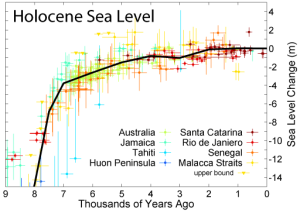Nicholas Flemming
Sea-Level Changes *
Sea-Level Changes. Recent years have seen the production of ever more detailed data relating to sea-level changes following the last Ice Age. In 2006 researchers discovered that the Bering Strait between Siberia and Alaska was created around 9000 BC, a thousand years earlier than previously thought.
Such changes could have had a direct bearing on the Atlantis mystery, particularly if Plato’s assertion that its inundation took place in 9600 BC is true, as this would place the event at the end of the last Ice Age and the melting of the glaciers with the consequent raising of the level of the oceans. Although we are usually given the impression that this deglaciation progressed steadily it would appear that in reality the process continued at different rates and was at times temporarily reversed.
Recent studies(f) have clearly indicated that aboriginal Australians have preserved memories of the rising sea level at the end of the last Ice Age.
A 2000 report(c) from Dr Robert Baker and Professor Peter G.Flood from the University of New England in New South Wales, suggests that 4,000 years ago sea levels “may have been up to two metres higher than at present and that sea levels have risen and fallen like a roller coaster over the last 6,000 years.” I would expect that sea levels two metres higher around 2000 BC would have left archaeological evidence on a global scale. Until that is forthcoming, I would treat this claim with caution.
Dr Robert Haworth who worked with Dr Baker endorsed the conclusions of Baker and Flood(k). A few years later Haworth found further evidence of higher temperatures and sea levels in the Sydney area 6,000 years ago(l).
 Estimates of the total change in sea levels vary between 300 and 500 ft. The most recent studies have estimated the rate of sea-level rise at an average of one metre per century punctuated by occasionally increased rates of 2.5 metres per century(a). To complicate the picture further, many areas in northern latitudes that had been depressed by the weight of the enormous ice sheets of the last Ice Age, rose considerably as a result of isostatic rebound when the glaciers melted.
Estimates of the total change in sea levels vary between 300 and 500 ft. The most recent studies have estimated the rate of sea-level rise at an average of one metre per century punctuated by occasionally increased rates of 2.5 metres per century(a). To complicate the picture further, many areas in northern latitudes that had been depressed by the weight of the enormous ice sheets of the last Ice Age, rose considerably as a result of isostatic rebound when the glaciers melted.
There is general agreement that the raising of the sea-levels had dramatic consequences worldwide. Vast landmasses, such as Sundaland, the Celtic Shelf, and the Caribbean were totally or partially submerged, leaving many of today’s islands as remnants. Communities that had flourished in these regions during the last Ice Age must have been devastated which naturally led to the generation of myths recalling their former glory. Atlantis is assumed to be one such legend with a firm basis in reality.
Other, more controversial effects have also been proposed, such as the breaching of a landbridge that had existed between Spain and North Africa at Gibraltar and/or a similar isthmus between Sicily and Tunisia. James Bramwell reports that in the 1930s geologists spoke freely of the breaching of a Gibraltar dam around 15,000 years ago. More recently, writers such as Joseph S. Ellul, Sergio Frau and Paulino Zamarro have convincingly based their Atlantis theories on this concept. The Mediterranean sea level is discussed elsewhere.
Other writers have proposed an asteroidal or cometary impact as the cause of catastrophic flooding, but such inundations would have receded fairly rapidly. In the end, we are left with the ending of the last Ice Age as the primary cause of profound changes in the topography of our planet that probably included the submergence of one civilisation that we now refer to as Atlantis.
However, Plato introduces another detail into his Atlantis narrative, namely that following the submergence of Atlantis, it created a maritime hazard in the form of shoals. Plato wrote that “wherefore also the ocean at that spot has now become impassable and unsearchable, being blocked up by the shoal of mud which the island created as it settled down.” (Timaeus 25d). The implication of this is that the shoals still existed in either Solon’s or Plato’s lifetime. We must also keep in mind that the draft of ships, such as triremes, at that time was about a metre. The attached chart shows how between 5000 BC and the present, the rate of sea level has been relatively slow. Even allowing for any local seismic, tectonic or isostatic activity I would interpret the data to suggest two important facts; first, the flooding of Atlantis could not have taken place before 5000 BC and still be a hazard in the first millennium BC and secondly if it occurred after 5000 BC Atlantis must be still in shallow water.
Kurt Lambeck has demonstrated from a study of Roman fish pens that the sea level along the Italian coast, 2000 years ago, was 1.35 metres below today’s levels. His investigations also included a study of land elevations along the coast that may have been affected by seismic or tectonic processes and found that they had raised the land by 1.22 metres, indicating that global sea levels had risen by just 13cm over the past two millennia, most of which has occurred over the past century(d)! Lambeck’s conclusions have been severely criticised by Izabol Apulia(e).
Professor Nicholas Flemming of the University of Southampton has written extensively on the subject of sea-level changes [1682], particularly in the Mediterranean(h). A more localised study of sea-level changes around Malta during the Holocene has been produced by an Italian team led by Stefan Furlani(i).
Furthermore, if the destruction took place before 5000 BC then either Solon or Plato concocted the description of the shoals, which would have no purpose whatsoever!
Sea level changes in the Gulf of Mexico are discussed in an online pdf file(b). In the same region, there is now claimed to be evidence(g) confirming that sea levels were lower during the last Ice Age and that the Yucatan Peninsula was very much larger.
A June 2021 report(j) concluded that Israeli sea levels rose at a relatively fast rate of 2 – 2.5 metres within 200 years between the Hellenistic and Roman periods. I am not aware of any corroboration from other sites in the region, so, lacking any such evidence, I am forced to conclude that this is more likely to have been the consequence of localised seismic activity rather than a more general rise in sea levels. On the other hand, seismic events are usually instant and not spread over centuries! Further investigation is required.
(a) https://www.sciencedaily.com/releases/2010/12/101201120605.htm
(c) https://web.archive.org/web/20110912071448/https://www.abc.net.au/quantum/stories/s112352.htm
(d) https://www.freerepublic.com/focus/news/1192397/posts
(e) See: Archive 2566
(f) https://theconversation.com/ancient-aboriginal-stories-preserve-history-of-a-rise-in-sea-level-36010
(g) https://phys.org/news/2016-11-dino-killing-crater-clues-ice-age.html
(h) https://www.gresham.ac.uk/watch-now/humanity-and-million-years-sea-level-change *
(i) https://www.researchgate.net/publication/235606249_Holocene_sea_level_change_in_Malta
(k) Atlantis Rising magazine # 22 p11
(l) https://www.abc.net.au/science/articles/2004/04/01/1078868.htm?site=tv&topic=latest
Négris, Phocion
Phocion Négris (1846-1928) was born in Athens but was educated in Paris where he spent 21 years. He qualified as a mining  engineer and obtained a degree in mathematical science. On his return to Greece, he became involved in politics and eventually served two terms as Minister for Finance.
engineer and obtained a degree in mathematical science. On his return to Greece, he became involved in politics and eventually served two terms as Minister for Finance.
Négris propounded the idea that Atlantis had been destroyed by glacial ice[486][487]. In 1904 he published, in French, a volume on ancient underwater ruins[686], which was republished in 1980.
In a communication to the 1905 International Congress of Archeology in Athens on ‘the question of Plato’s Atlantis’. He noted in particular: “So the agreement between Plato’s story and geological phenomena continues down to the smallest details. All doubt must cease; Atlantis existed. “(a)
Négris’ 1905 French translation of Critias was combined by Lewis Spence with that of Jolibois to provide a composite translation in The History of Atlantis.
>Négris is credited as the first person to discover the sunken city of Pavlopetri in 1904, which lay unexplored until 1967 when it was rediscovered by Nicholas Flemming.<
